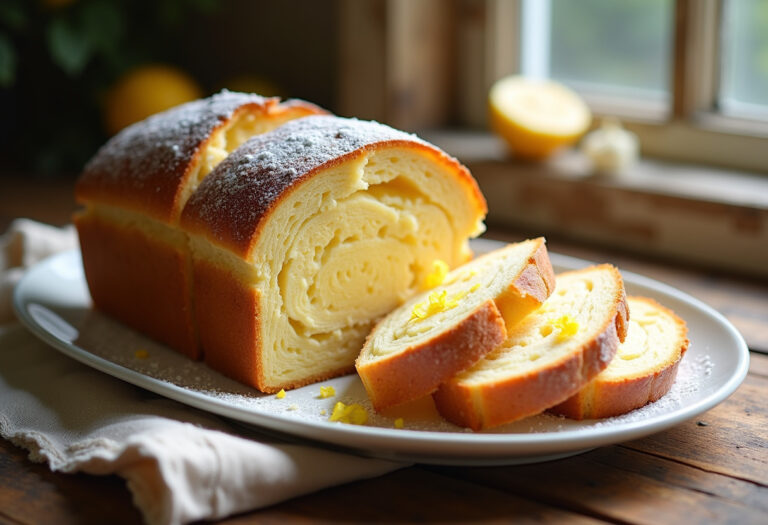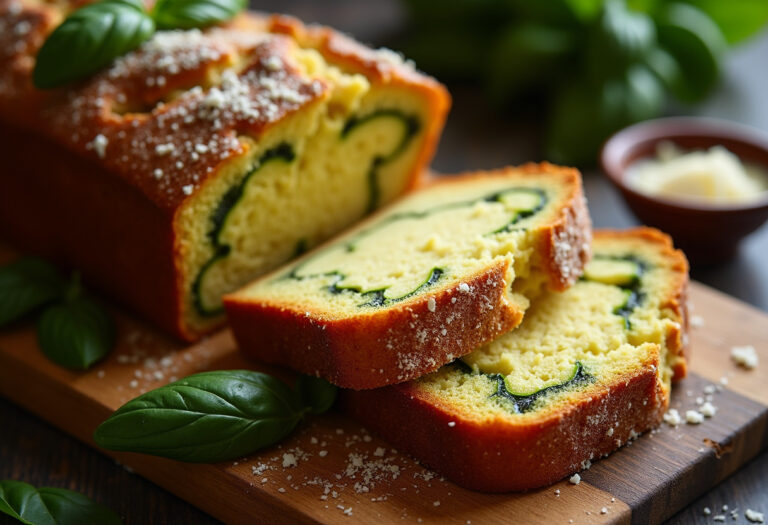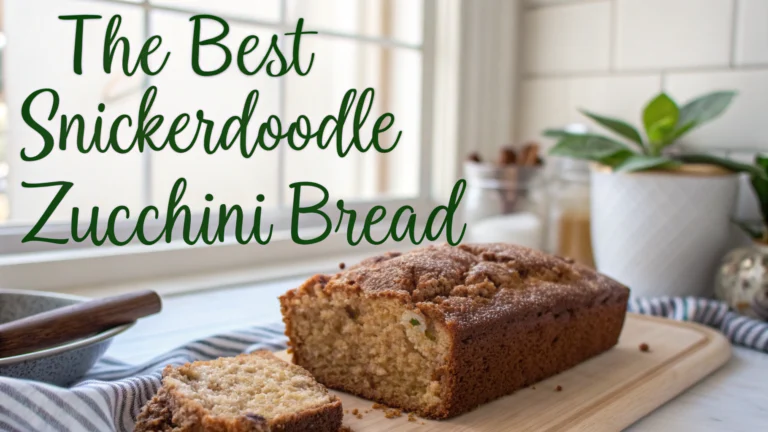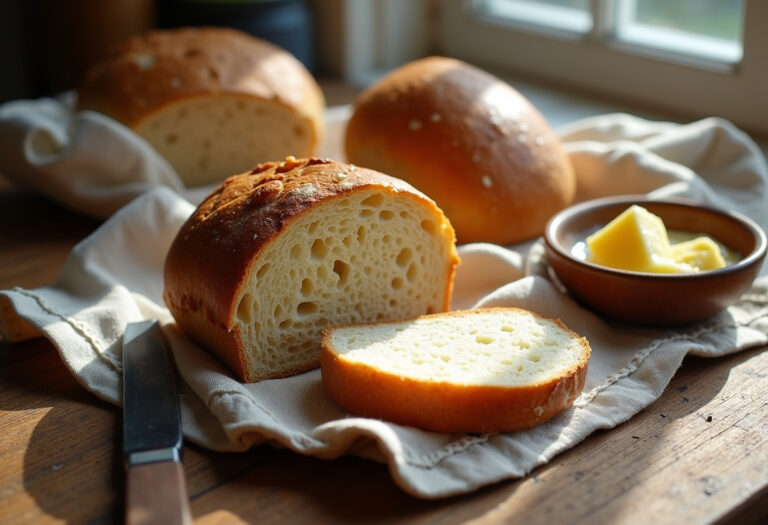Crusty Italian Bread
Introduction
Crusty Italian Bread is a delightful creation that embodies the essence of traditional Italian baking. With its golden, crispy crust and soft, chewy interior, this bread is a culinary masterpiece that elevates any meal it accompanies.
Why choose this Crusty Italian Bread recipe?
Choosing this Crusty Italian Bread recipe means opting for a bakery-style treat that is both simple to make and incredibly rewarding. The perfect balance of textures, the use of basic pantry ingredients, and the artisanal touch achieved through an easy steam baking technique make this recipe a standout choice for any home baker.
Ingredients for Crusty Italian Bread
- 4 cups all-purpose flour
- 1 1/2 teaspoons salt
- 1 tablespoon sugar
- 1 tablespoon olive oil
- 1 packet (2 1/4 teaspoons) active dry yeast
- 1 1/2 cups warm water (110°F/45°C)
- Cornmeal (for dusting)
- Extra flour for kneading
Preparation Steps for Crusty Italian Bread
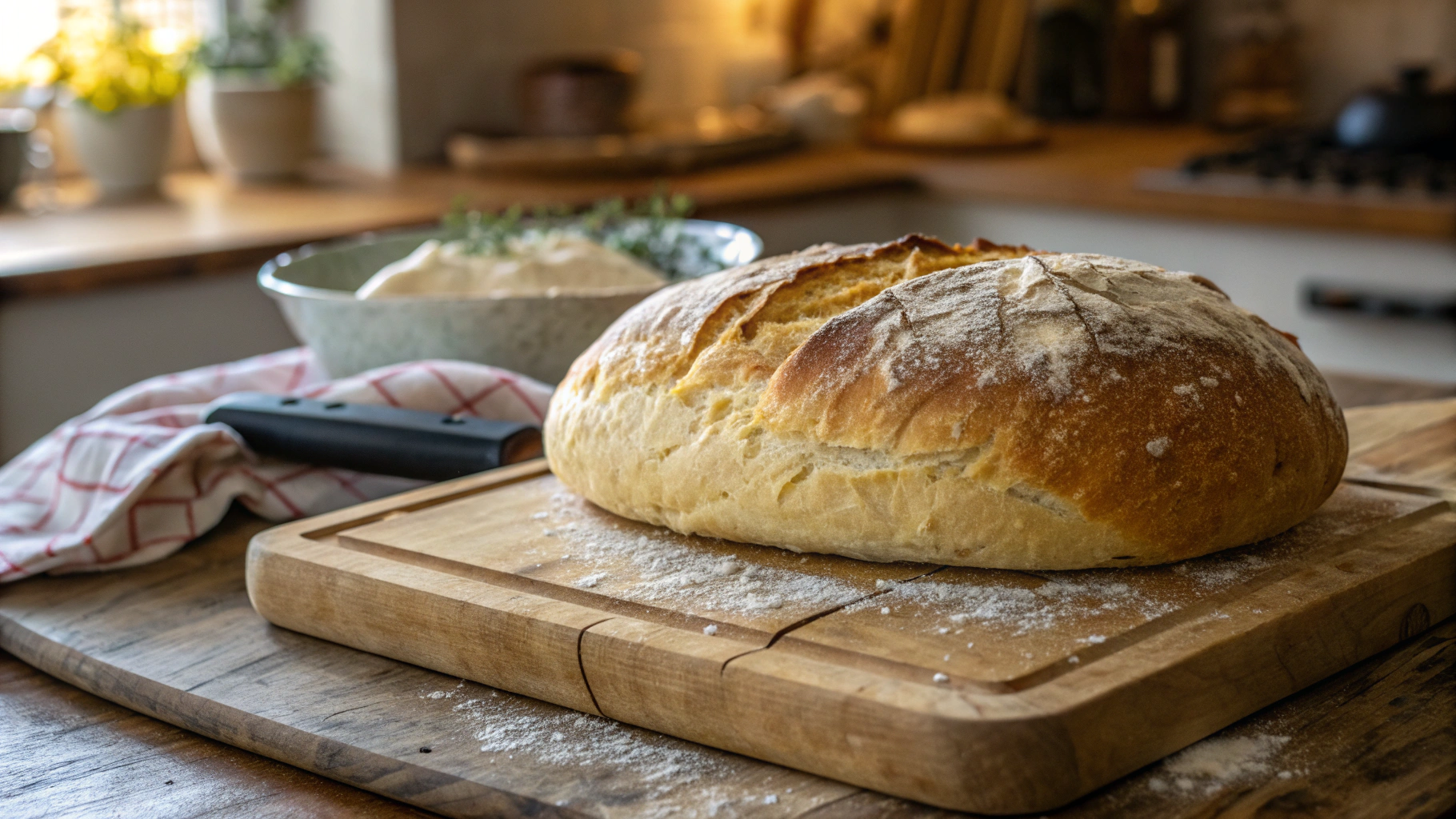
Step 1: Prepare the Yeast Mixture
To kick off this delightful baking journey, dissolve sugar in warm water in a large bowl. Sprinkle the yeast over the top and allow it to sit until foamy, usually around 5–10 minutes. This step is crucial for activating the yeast and ensuring a perfect rise in your bread.
Step 2: Mix in Olive Oil and Salt
Once the yeast mixture is ready, stir in the olive oil and salt. Gradually incorporate the flour, one cup at a time, ensuring thorough mixing until a shaggy dough starts to form. This stage sets the foundation for the bread’s texture and flavor.
Step 3: Knead the Dough
Turn the dough out onto a floured surface and commence the kneading process. Work the dough for about 8–10 minutes until it transforms into a smooth and elastic consistency. Proper kneading is key to developing the bread’s structure.
Step 4: Let the Dough Rise
Transfer the kneaded dough into a lightly oiled bowl, cover it with a damp towel or plastic wrap, and let it rise in a warm place for 1 to 1.5 hours, or until it doubles in size. This resting period allows the flavors to develop and the dough to expand.
Step 5: Shape and Second Rise
After the dough has doubled, punch it down and shape it into a round or oblong loaf. Place the shaped dough on a baking sheet dusted with cornmeal. Cover it loosely and let it rise again for 30–40 minutes until it looks nicely puffed, ready for baking.
Step 6: Preheat and Slash the Dough
While the dough is on its final rise, preheat the oven to 425°F (220°C). Place an oven-safe pan of hot water on the bottom rack to create steam. Just before baking, make 2–3 slashes across the top of the loaf with a sharp knife to allow for controlled expansion during baking.
Step 7: Bake to Perfection
Bake the prepared loaf for 25–30 minutes, or until the crust turns a glorious golden hue and the bread emits a hollow sound when tapped. Once baked, allow the bread to cool on a wire rack before slicing into this delectable Crusty Italian Bread.
Health Benefits of Crusty Italian Bread
Crusty Italian bread, despite its reputation for being a simple carbohydrate, can actually offer some health benefits. This type of bread is typically low in fat, cholesterol-free, and a good source of carbohydrates for energy. Additionally, if made with whole wheat flour, it can provide fiber for digestive health and essential nutrients like iron and B vitamins. Enjoying crusty Italian bread in moderation as part of a balanced diet can be a tasty and satisfying choice.
Origin and History of the Crusty Italian Bread Recipe
The tradition of baking crusty Italian bread dates back centuries in Italy, where bread is a staple in the Mediterranean diet. The recipe for this iconic bread varies from region to region but typically includes basic ingredients like flour, yeast, salt, and water. Italian bakers have perfected the art of creating a crispy crust and soft interior through techniques like steam baking and precise kneading. Today, crusty Italian bread is enjoyed worldwide and remains a symbol of Italian culinary craftsmanship.
Delicious Variations Around Crusty Italian Bread
While traditional crusty Italian bread is a beloved classic, there are endless ways to put a unique spin on this versatile loaf:
- Adding herbs like rosemary, thyme, or oregano to the dough for a fragrant twist.
- Experimenting with different flours like whole wheat or rye for added flavor and nutrition.
- Incorporating ingredients like olives, sun-dried tomatoes, or cheese for a savory touch.
- Shaping the dough into rolls, twists, or braids for individual servings or a decorative presentation.
Chef’s Tips for Perfecting Your Crusty Italian Bread
To ensure your crusty Italian bread turns out bakery-worthy every time, consider these expert tips:
- Use high-quality ingredients, including bread flour for a chewier texture and better gluten development.
- Allow enough time for the dough to rise properly, as this is crucial for developing flavor and structure.
- Preheat your oven adequately and create steam by placing a pan of hot water inside to achieve a crisp crust.
- Experiment with scoring patterns on the dough before baking to control how the bread expands in the oven.
Mistakes to Avoid When Preparing Crusty Italian Bread
When baking Crusty Italian Bread, there are a few common mistakes to steer clear of to ensure your loaf turns out perfectly. One mistake to avoid is over-kneading the dough, which can result in a tough texture instead of the desired light and airy crumb. Additionally, be cautious not to skimp on the rising time, as proper proofing is crucial for achieving that signature crust and soft interior. Lastly, make sure to preheat your oven adequately and maintain the steam level to create the ideal baking environment for a crispy crust.
Ingredient Alternatives for Crusty Italian Bread
While the traditional recipe for Crusty Italian Bread calls for specific ingredients, there are some alternatives you can experiment with to customize the flavor and texture of your loaf. Consider using whole wheat flour or a combination of different flours to add depth to the taste. You can also swap olive oil for melted butter for a richer mouthfeel or incorporate herbs like oregano or basil for a fragrant twist. Don’t hesitate to play around with the recipe to suit your preferences and create a unique variation of this classic bread.
Tips and Tricks to Perfect Your Crusty Italian Bread
Mastering the art of baking Crusty Italian Bread requires attention to detail and some insider tips to elevate your loaf to bakery-quality standards. To achieve a crispier crust, try spritzing the dough with water before baking or brushing it with an egg wash for a shiny finish. For a more flavorful bread, let the dough ferment in the refrigerator overnight to develop complex tastes. Additionally, experiment with different scoring patterns on the loaf to create decorative designs that not only look impressive but also allow for controlled expansion during baking.
Side Dish Suggestions for Crusty Italian Bread
Pairing Crusty Italian Bread with the right side dishes can enhance your dining experience and complement the bread’s flavors. Serve slices of warm bread alongside a classic Caprese salad with fresh tomatoes, basil, and mozzarella for a refreshing accompaniment. Alternatively, create a charcuterie board featuring an assortment of cured meats, cheeses, olives, and pickles to enjoy with the bread. For a heartier option, use the bread to make gourmet grilled cheese sandwiches or open-faced bruschetta topped with flavorful ingredients like roasted vegetables or creamy burrata cheese.
3221″ data-end=”3683″>How to store the recipe Crusty Italian Bread after cooking?
Once the Crusty Italian Bread is fully baked and cooled, it’s best to store it properly to maintain its texture and flavor. Wrap the bread in a clean kitchen towel or place it in a paper bag at room temperature for up to 2 days. For longer storage, tightly wrap the bread in plastic and freeze it. When ready to enjoy again, reheat slices in the oven at 350°F for about 5–7 minutes or toast them individually for that freshly baked taste.
Can the recipe Crusty Italian Bread be prepared in advance?
Yes, you can prepare the Crusty Italian Bread dough in advance to save time on busy days. After the first rise, shape the dough into a loaf, cover it tightly, and refrigerate it overnight. The next day, allow the dough to come to room temperature and rise for the second time before baking as directed. This make-ahead method ensures you have freshly baked bread with minimal effort when you need it.
What ingredients can be substituted in the recipe Crusty Italian Bread?
If you’re looking to switch up the ingredients in the Crusty Italian Bread recipe, there are some options for substitutions. You can experiment with different types of flour like whole wheat or bread flour for varied textures. For a sweeter version, replace sugar with honey or maple syrup. Olive oil can be swapped with melted butter or vegetable oil for a different flavor profile. Feel free to customize the bread to suit your taste preferences while keeping the overall structure of the recipe intact.
How to adapt the recipe Crusty Italian Bread for a vegetarian version?
To make a vegetarian version of the Crusty Italian Bread, ensure that all ingredients used are plant-based and free from any animal products. Double-check that the yeast is suitable for vegetarians, as some may contain animal-derived components. You can enhance the flavor by adding herbs like rosemary or thyme to the dough for a fragrant twist. Follow the recipe instructions as usual, making sure to use vegan-friendly alternatives for any dairy-based ingredients. This adaptation allows you to enjoy a delicious loaf of Crusty Italian Bread while adhering to a vegetarian diet.
Is the recipe Crusty Italian Bread suitable for children?
The Crusty Italian Bread recipe is a family-friendly option that can be enjoyed by children, especially those who appreciate the simplicity of homemade bread. Kids can participate in the baking process by helping with tasks like mixing ingredients, shaping the dough, or making decorative slashes on the loaf. The bread’s mild flavor and versatile texture make it a versatile choice for sandwiches, toast, or snacks that kids are sure to enjoy. With adult supervision, children can experience the joy of baking and savoring a warm slice of freshly baked Crusty Italian Bread.
Conclusion about the recipe Crusty Italian Bread
In conclusion, Crusty Italian Bread is a delightful creation that embodies the essence of traditional homemade baking. With its golden crust, soft interior, and simple ingredients, this bread recipe offers a rewarding experience for both novice and experienced bakers. Whether enjoyed fresh out of the oven or stored for later indulgence, Crusty Italian Bread provides a versatile canvas for various flavor adaptations and serving suggestions. Embrace the art of bread-making with this timeless recipe and savor the satisfaction of creating a classic loaf that never fails to impress.
📌 Keep This Recipe Handy & Discover More Tasty Ideas!
Enjoyed this recipe? Don’t let it slip away! Save it now on Pinterest so it’s always just a click away. Pinning it also helps others find simple, delicious meal ideas!
💡 Whether you’re organizing your weekly meal plan or whipping up something special for guests, having your go-to recipes saved makes life in the kitchen so much easier. Use Pinterest to collect your favorites, explore new versions of classic dishes, and revisit your top meals anytime.
📲 Don’t forget to follow us on Pinterest for a daily dose of inspiration — from cozy family dinners and quick lunches to seasonal desserts and healthy snacks. We update regularly with recipes designed to fit your lifestyle and taste.
📖 Craving more? Head over to our full recipe library to browse a wide variety of easy and flavorful dishes. No matter your skill level, you’ll find recipes that are simple to make and packed with flavor.
✨ Bookmark your favorites and swing by often — there’s always something fresh and delicious waiting for you!
